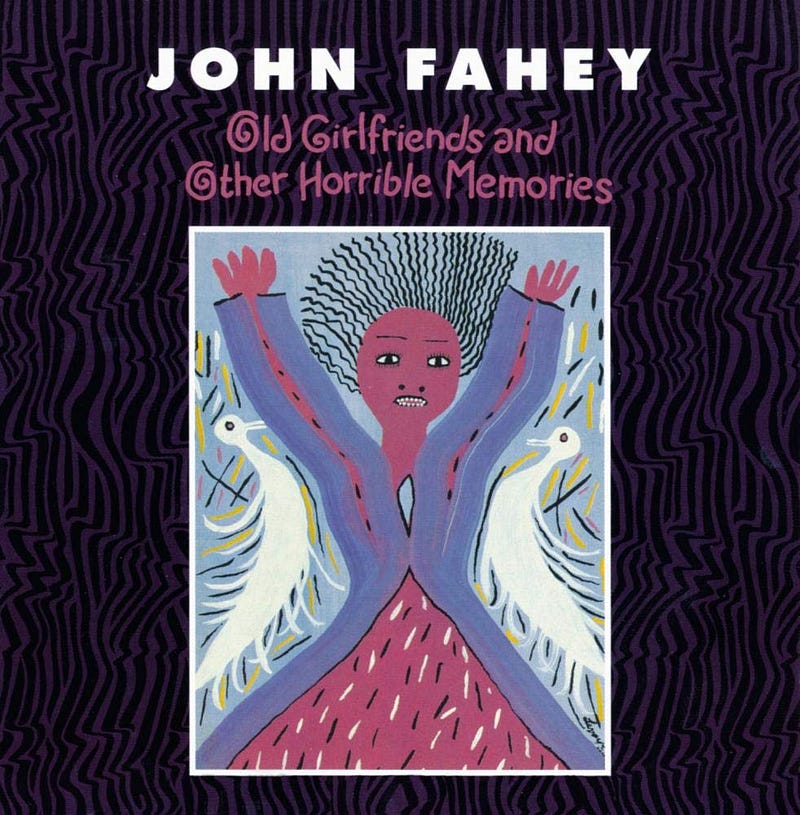John Fahey — Old Girlfriends and Other Horrible Memories
16.September.2020
John Fahey
Old Girlfriends and Other Horrible Memories
1992
John Fahey may be one of the most influential guitarists you’ve never heard …or listened to.
Embracing blues, folk, and American roots, the self-taught Fahey helped create a fingerpicking style of playing that would become the foundation of the American primitive guitar genre.
Fahey would later incorporate 20th-century classical, Portuguese, Brazilian, and Indian influences into his work.
One of the first things you notice when listening to John Fahey is his agility and technical talents. His “unique tuning, repetition, dissonance, and layered melody” can almost put you in a trance-like state. All of those things helped John Fahey place 35th on David Fricke and Rolling Stone’s “100 Greatest Guitarists of All Time.”
Released in 1992, but recorded in 1988 and 1990, Old Girlfriends and Other Horrible Memories, aside from being an excellent name for an album, would be the last studio album for Fahey. He would then begin a decade long downward spiral in his personal life, health, and career.
The album opens with two standard classics, “Twilight Time,” and “Sea of Love.” The first seems an odd choice as an opener and the second certainly fits in with the theme of the album. Through his unique playing style, Fahey’s interpretation of these classic’s finds a way to make them sound new and unique.
Old Girlfriends and Other Horrible Memories is a mix of covers and Fahey originals. Fahey wrote eight of the albums twelve tracks. Using audio as his canvas and his guitar as a brush, these tracks paint a picture. However, despite the album’s title, the songs themself don’t have a necessarily haunting or harsh sound that may be equated with the word “horrible”, but they paint a picture:
“Claire” — simple picking and intricate rhythm, painful and too angry to use her last name.
“The Thing at the End of New Hampshire Avenue” — judging by the sound of this tune, I think it may be a restaurant that’s at the end of New Hampshire Avenue.
“Don’t” — who hasn’t said this to someone they love as they’re leaving you? This track is almost lethargic, which matches the sentiment of the word “Don’t.”
“View” — a jaunty tune that makes me think about the first “view” you get of your partner in the buff.
“Dianne Kelly” — unlike “Claire” Fahey is calling her out, this song evokes sadness. Classic blues sound.
“Fear & Loathing at 4th & Butternut” — the most avant-garde sounding song on the album.
“Twilight on Prince Georges Avenue” — this song paints an image of someone lonely walking home after a break-up …perhaps along Prince Georges Avenue.
In the documentary In Search of Blind Joe Death: The Saga of John Fahey, Pete Townsend of The Who said:
“Could I go so far as to say he is the innovator? I think yes … he is definitely worthy of the term iconoclast.”
John Fahey’s music isn’t just for guitar players. His songs all have a degree of accessibility that makes it easy and pleasant to listen to.
CRITICS:
Richard Mayer — AllMusic: “John Fahey, whose seminal solo guitar albums led the way for a zillion other guitar players, has made another fine one himself. All his trademark elements are here, eclectic song choices, dark and precise playing, and a sense of fun.”
As a founder of Takoma Records, Fahey helped launch the careers of:
Leo Kotke
George Winston
Mike Bloomfield
The Fabulous Thunderbirds
Eventually selling Takoma to Chrysalis Records, he would spend the remainder of his career bouncing around labels like Reprise Records and Varrick Records.
As he was slowly sliding into alcoholism and oblivion, artists like Sonic Youth, Cul de Sac, and Jim O’Rourke discovered him in the mid-’90s. A brief upswing in popularity took place, but sadly John Fahey died after undergoing a sextuple coronary bypass.
As the last studio recording by John Fahey, Old Girlfriends and Other Horrible Memories is a great album for the guitar master to hang his hat on. It’s also one of the many reasons why Fahey is considered a “giant 20th-century American music.”




